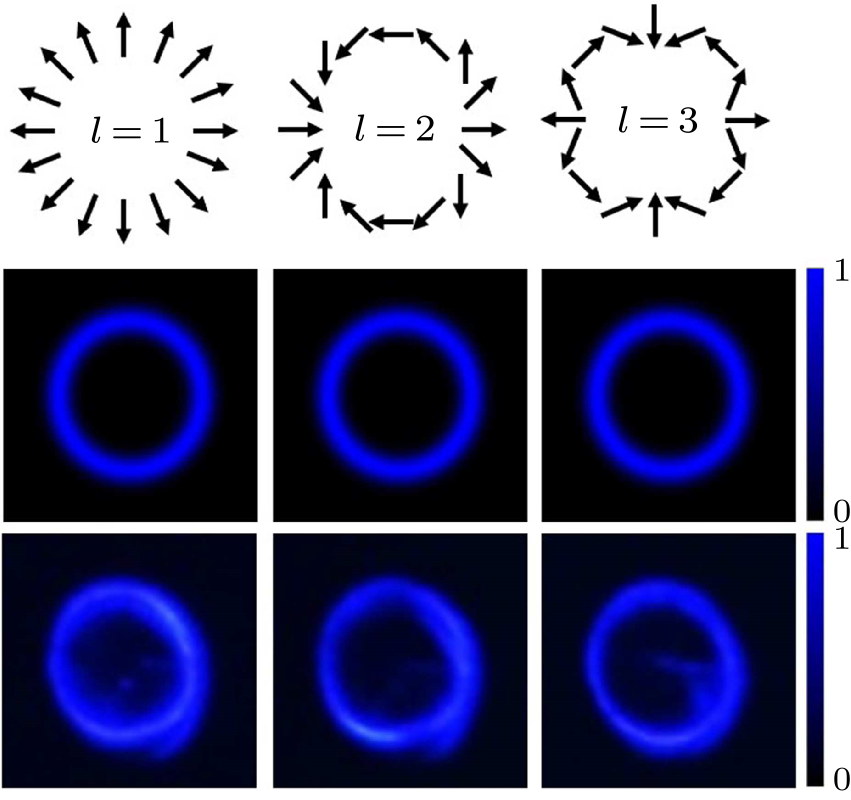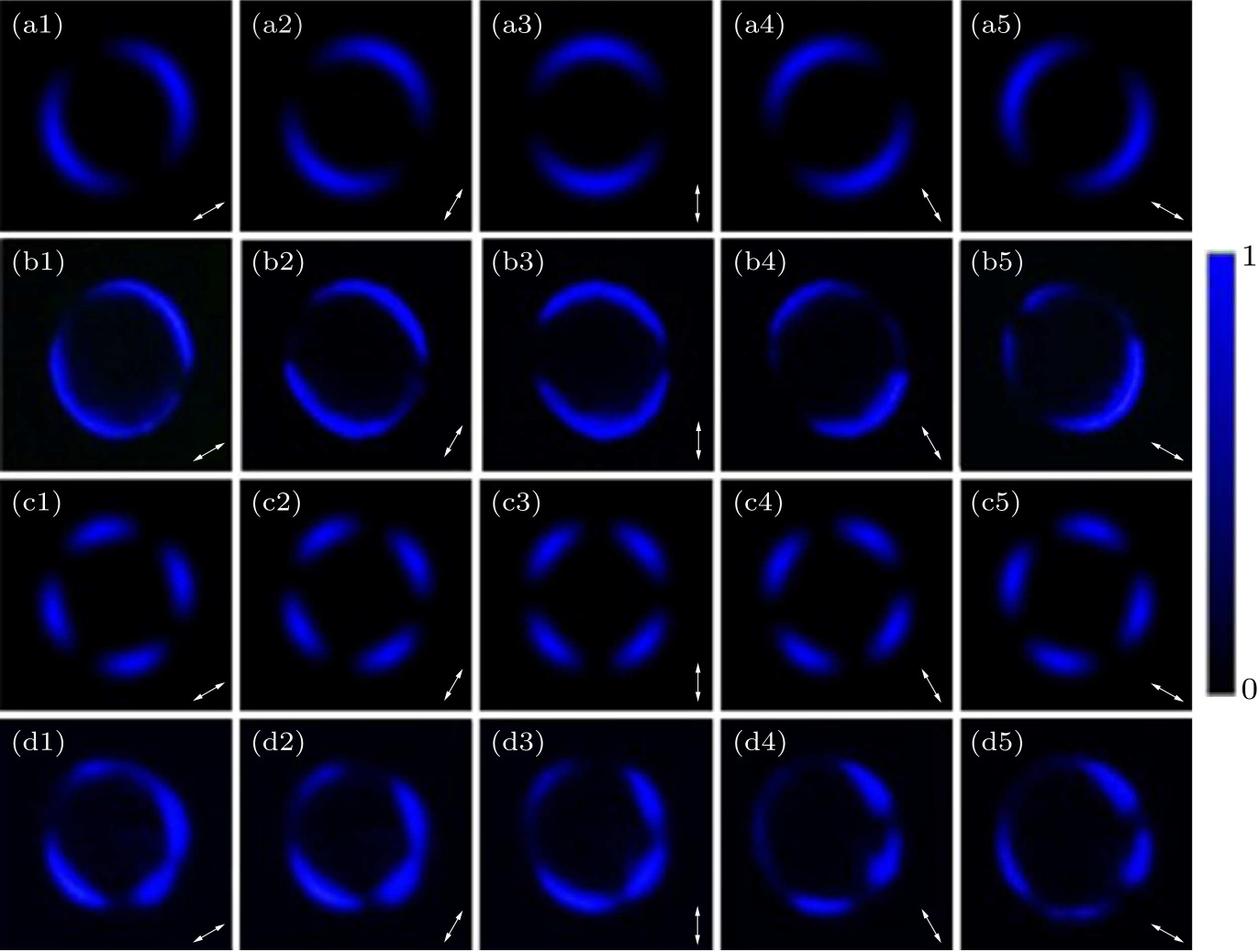




Fig. 1. Schematic of experimental setup. GT prism: Glan–Taylor prism; S$_{1}$: 5 mol% MgO:LiNbO$_{3}$; DM$_{1}$ and DM$_{2}$: dichroic mirror; HWP$_{1}$ and HWP$_{2}$: half waveplates operating at 1064 and 532 nm, respectively; QWP$_{1}$ and QWP$_{2}$: quarter waveplates with operating wavelengths of 1064 and 355 nm, respectively; PBS: polarized beam splitter; M$_{1}$, M$_{2}$, M$_{3}$, and M$_{4}$: mirrors; SPP: spiral phase plate; S$_{2}$, S$_{3}$: potassium dihydrogen phosphate (KDP) crystals; F: filter; S: screen. V and H in the lower left corner denote the vertical and horizontal directions, respectively.

Fig. 2. Intensity and polarization distribution of generated ultraviolet PV beams with topological charges $l = 1,\, 2,\, 3$. The first row describes the polarization distribution. The second and third rows denote the simulation and experimental results, respectively.

Fig. 3. (a1)–(a5) and (c1)–(c5) respectively represent the simulated intensity profiles of the ultraviolet PV beams with topological charges $l = 1,\, 2$ when the GT prism has different polarization angles (30$^{\circ}$, 60$^{\circ}$, 90$^{\circ}$, 120$^{\circ}$, 150$^{\circ}$) with respect to the horizontal direction. The corresponding experimental results are shown in (b1)–(b5) and (d1)–(d5). The arrows in the lower right corner of the figures show the polarization angles of the GT prism with respect to the horizontal direction.

Fig. 4. Variation of the power of the generated ultraviolet PV beams with topological charge $l$.
| [1] | Hnatovsky C, Shvedov V, Krolikowski W, and Rode A 2011 Phys. Rev. Lett. 106 123901 | Revealing Local Field Structure of Focused Ultrashort Pulses
| [2] | Zhao Y, Zhan Q, Zhang Y, and Li Y P 2005 Opt. Lett. 30 848 | Creation of a three-dimensional optical chain for controllable particle delivery
| [3] | Chen Y and Cai Y 2014 Opt. Lett. 39 2549 | Generation of a controllable optical cage by focusing a Laguerre–Gaussian correlated Schell-model beam
| [4] | Weng X, Du L, Shi P, and Yuan X 2017 Opt. Express 25 9039 | Tunable optical cage array generated by Dammann vector beam
| [5] | Ndagano B, Nape I, Cox M A, Rosales-Guzman C, and Forbes A 2018 J. Lightwave Technol. 36 292 | Creation and Detection of Vector Vortex Modes for Classical and Quantum Communication
| [6] | Parigi V, D'Ambrosio V, Arnold C, Marrucci L, Sciarrino F, and Laurat J 2015 Nat. Commun. 6 7706 | Storage and retrieval of vector beams of light in a multiple-degree-of-freedom quantum memory
| [7] | Ren Z C, Lou Y C, Cheng Z M, Fan L, Ding J, Wang X L, and Wang H T 2021 Opt. Lett. 46 2300 | Optical frequency conversion of light with maintaining polarization and orbital angular momentum
| [8] | Chen P, Ji W, Wei B Y, Hu W, Chigrinov V, and Lu Y Q 2015 Appl. Phys. Lett. 107 241102 | Generation of arbitrary vector beams with liquid crystal polarization converters and vector-photoaligned q-plates
| [9] | Zhu X, Yu J, Wang F, Chen Y, Cai Y, and Korotkova O 2021 Opt. Lett. 46 2996 | Synthesis of vector nonuniformly correlated light beams by a single digital mirror device
| [10] | Lou S, Zhou Y, Yuan Y, Lin T, Fan F, Wang X, Huang H, and Wen S 2019 Opt. Express 27 8596 | Generation of arbitrary vector vortex beams on hybrid-order Poincaré sphere based on liquid crystal device
| [11] | Wang D, Pan Y, Lü J Q, Li P P, Liu G G, Cai M Q, Li Y, Tu C, and Wang H T 2018 J. Opt. Soc. Am. B 35 2373 | Controlling optical field collapse by elliptical symmetry hybrid polarization structure
| [12] | Xu R, Chen P, Tang J, Duan W, Ge S J, Ma L L, Wu R, Hu W, and Lu Y Q 2018 Phys. Rev. Appl. 10 034061 | Perfect Higher-Order Poincaré Sphere Beams from Digitalized Geometric Phases
| [13] | Zhao R, Huang L, Tang C, Li J, Li X, Wang Y, and Zentgraf T 2018 Adv. Opt. Mater. 6 1800490 | Nanoscale Polarization Manipulation and Encryption Based on Dielectric Metasurfaces
| [14] | Tang Y, Intaravanne Y, Deng J, Li K F, Chen X, and Li G 2019 Phys. Rev. Appl. 12 024028 | Nonlinear Vectorial Metasurface for Optical Encryption
| [15] | Yue F, Wen D, Xin J, Gerardot B D, Li J, and Chen X 2016 ACS Photon. 3 1558 | Vector Vortex Beam Generation with a Single Plasmonic Metasurface
| [16] | Zhang Y, Yang X, and Gao J 2019 Phys. Rev. Appl. 11 064059 | Generation of Nondiffracting Vector Beams with Ring-Shaped Plasmonic Metasurfaces
| [17] | Liu X, Monfared Y E, Pan R, Ma P, Cai Y, and Liang C 2021 Appl. Phys. Lett. 119 021105 | Experimental realization of scalar and vector perfect Laguerre–Gaussian beams
| [18] | Han W, Yang Y, Cheng W, and Zhan Q 2013 Opt. Express 21 20692 | Vectorial optical field generator for the creation of arbitrarily complex fields
| [19] | Hernández-García C, Turpin A, Román J S, Picón A, Drevinskas R, Cerkauskaite A, Kazansky P G, Durfee C G, and Sola Íñigo J 2017 Optica 4 520 | Extreme ultraviolet vector beams driven by infrared lasers
| [20] | Radwell N, Hawley R D, Götte J B, and Franke-Arnold S 2016 Nat. Commun. 7 10564 | Achromatic vector vortex beams from a glass cone
| [21] | Sakakura M, Lei Y, Wang L, Yu Y H, and Kazansky P G 2020 Light: Sci. & Appl. 9 15 | Ultralow-loss geometric phase and polarization shaping by ultrafast laser writing in silica glass
| [22] | Maurer C, Jesacher A, Fürhapter S, Bernet S, and Ritsch-Marte M 2007 New J. Phys. 9 78 | Tailoring of arbitrary optical vector beams
| [23] | Chen P, Ge S J, Duan W, Wei B Y, Cui G X, Hu W, and Lu Y Q 2017 ACS Photon. 4 1333 | Digitalized Geometric Phases for Parallel Optical Spin and Orbital Angular Momentum Encoding
| [24] | Cohen E, Larocque H, Bouchard F, Nejadsattari F, Gefen Y, and Karimi E 2019 Nat. Rev. Phys. 1 437 | Geometric phase from Aharonov–Bohm to Pancharatnam–Berry and beyond
| [25] | Zhang Y H, Chen P, Ge S J, Wei T, Tang J, Hu W, and Lu Y Q 2020 Appl. Phys. Lett. 117 081101 | Spin-controlled massive channels of hybrid-order Poincaré sphere beams
| [26] | Li P, Zhang Y, Liu S, Ma C, Han L, Cheng H, and Zhao J 2016 Opt. Lett. 41 2205 | Generation of perfect vectorial vortex beams
| [27] | Fu S, Gao C, Wang T, Zhang S, and Zhai Y 2016 Opt. Lett. 41 5454 | Simultaneous generation of multiple perfect polarization vortices with selective spatial states in various diffraction orders
| [28] | Li D, Feng S, Nie S, Chang C, Ma J, and Yuan C 2019 J. Appl. Phys. 125 073105 | Generation of arbitrary perfect Poincaré beams
| [29] | Liu Y, Ke Y, Zhou J, Liu Y, Luo H, Wen S, and Fan D 2017 Sci. Rep. 7 44096 | Generation of perfect vortex and vector beams based on Pancharatnam-Berry phase elements
| [30] | Li H, Liu H, and Chen X 2019 Photon. Res. 7 1340 | Dual waveband generator of perfect vector beams
| [31] | Liu D, Liu S, Mazur L, Wang B, Lu P, Krolikowski W, and Sheng Y 2020 Appl. Phys. Lett. 116 051104 | Smart optically induced nonlinear photonic crystals for frequency conversion and control
| [32] | Liu M, Huo P, Zhu W, Zhang C, Zhang S, Song M, Zhang S, Zhou Q, Chen L, Lezec H J, Agrawal A, Lu Y, and Xu T 2021 Nat. Commun. 12 2230 | Broadband generation of perfect Poincaré beams via dielectric spin-multiplexed metasurface
| [33] | Li L, Chang C, Yuan C, Feng S, Nie S, Ren Z C, Wang H T, and Ding J 2018 Photon. Res. 6 1116 | High efficiency generation of tunable ellipse perfect vector beams
| [34] | Li D, Chang C, Nie S, Feng S, Ma J, and Yuan C 2018 Appl. Phys. Lett. 113 121101 | Generation of elliptic perfect optical vortex and elliptic perfect vector beam by modulating the dynamic and geometric phase
| [35] | Wu H J, Zhao B, Rosales-Guzman C, Gao W, Shi B S, and Zhu Z Z 2020 Phys. Rev. Appl. 13 064041 | Spatial-Polarization-Independent Parametric Up-Conversion of Vectorially Structured Light
| [36] | Liu H, Li H, Zheng Y, and Chen X 2018 Opt. Lett. 43 5981 | Nonlinear frequency conversion and manipulation of vector beams
| [37] | Li H, Liu H, Yang Y, Lu R, and Chen X 2021 Appl. Phys. Lett. 119 011104 | Ultraviolet waveband vector beams generation assisted by the nonlinear frequency conversion
| [38] | Saripalli R K, Ghosh A, Chaitanya N A, and Samanta G K 2019 Appl. Phys. Lett. 115 051101 | Frequency-conversion of vector vortex beams with space-variant polarization in single-pass geometry